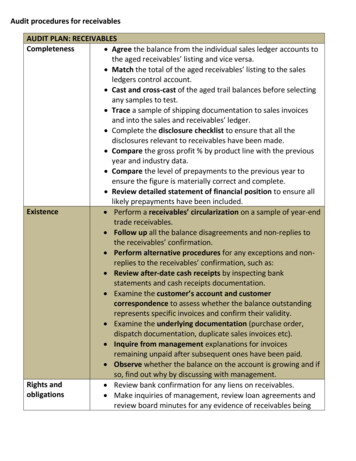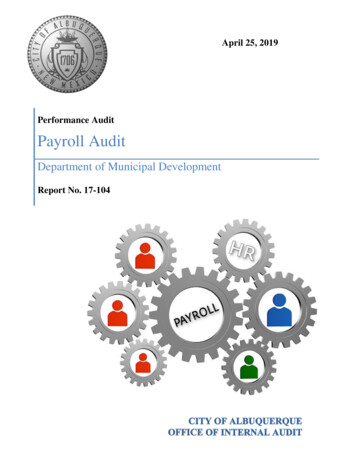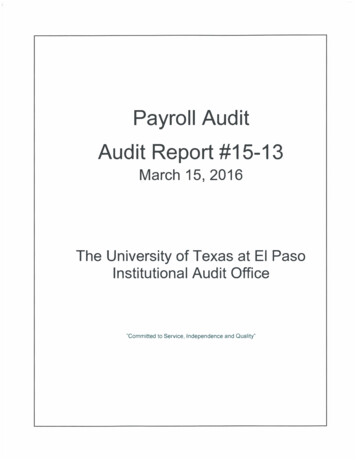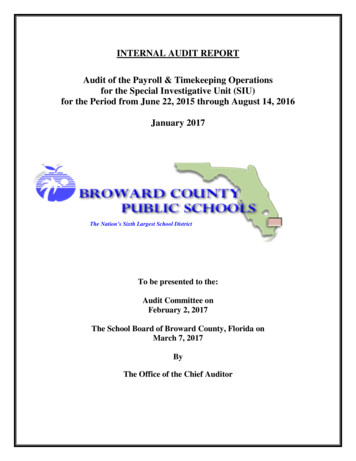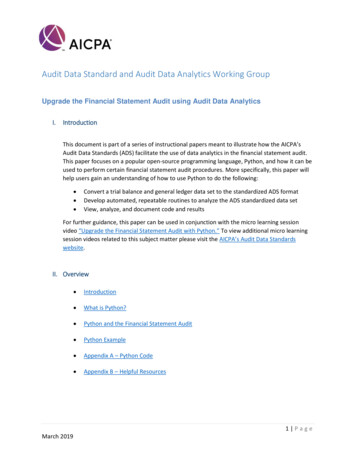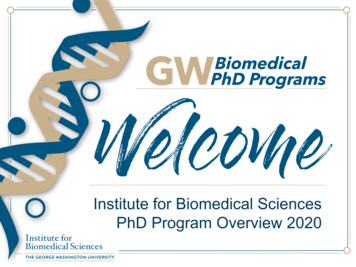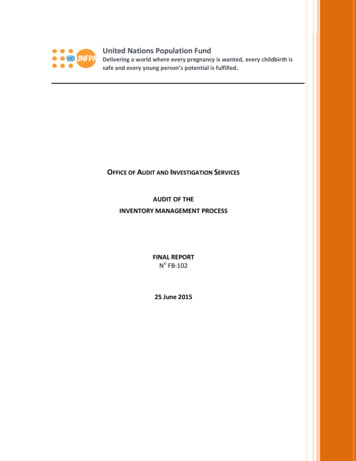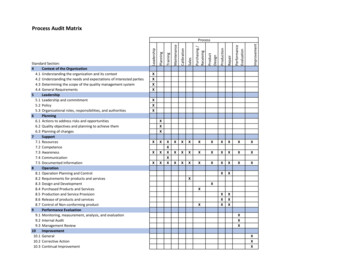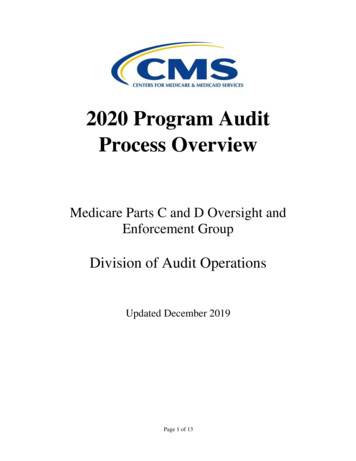
Transcription
2020 Program AuditProcess OverviewMedicare Parts C and D Oversight andEnforcement GroupDivision of Audit OperationsUpdated December 2019Page 1 of 13
Table of ContentsI.Executive Summary – 2020 Audit Process Timeline . 3II.Background . 4III.Summary of Audit Phases . 4Phase I: Audit Engagement and Universe Submission . 5Phase II: Audit Field Work . 7Phase III: Audit Reporting . 9Phase IV: Audit Validation and Close Out . 10Page 2 of 13
I.Executive Summary – 2020 Audit Process TimelinePhase I: AuditEngagement andUniverse SubmissionPhase II: Audit FieldWorkPhase III: AuditReportingPhase IV: AuditValidation and CloseOut Engagement Letter – CMS notification to sponsoring organization of audit selection; identification of audit scopeand logistics; and instructions for audit submissions Universe Submission – Sponsoring organization submission of requested universes and supplementaldocumentation to CMS Universe Integrity Testing – CMS integrity testing of sponsoring organization's universe submissions Audit Sample Selection – CMS selection of sample cases to be tested during audit field work Entrance Conference – Discussion of CMS audit objectives and expectations; sponsoring organization voluntarypresentation on organization Webinar Reviews – CMS testing of sample cases and review of supporting documentation live in sponsoringorganization systems via webinar Onsite Audit of Compliance Program Effectiveness – Sponsoring organization presentation of complianceprogram tracer reviews and submission of supporting documentation (screenshots, root cause analyses, impactanalyses, etc.); CMS documentation analysis Preliminary Draft Audit Report Issuance – CMS issuance of a preliminary draft report to sponsoring organizationidentifying the preliminary conditions and observations noted during the audit Exit Conference – CMS review and discussion of preliminary draft audit report with sponsoring organization Condition Classification and Audit Scoring – CMS classifiication of non-compliance and calculation of sponsoringorganization’s audit score Notification of Immediate Corrective Action Required (ICAR) conditions (as applicable) – CMS notification tosponsoring organization of any conditions requiring immediate corrective action; sponsoring organization ICARCorrective Action Plan (CAP) submission within three business days Draft Audit Report Issuance – CMS issuance of draft audit report, inclusive of condition classification and auditscore, to sponsoring organization approximately 60 calendar days after exit conference Draft Audit Report Response – Sponsoring organization submission of comments to draft audit report within 10business days of draft audit report receipt Final Audit Report Issuance – CMS issuance of final audit report with CMS responses to sponsoring organization'scomments and updated audit score (if applicable) approximately 10 business days after receipt of sponsoringorganization's comments to draft audit report Non-ICAR CAP Submission – Sponsoring organization's submission of non-ICAR CAPs within 30 calendar days offinal audit report issuance CAP Review and Acceptance – CMS performance of CAP reasonableness review and notification to sponsoringorganization of acceptance or need for revision Validation Audit – Sponsoring organization demonstration of correction of audit conditions cited in the final auditreport via validation audit within 180 calendar days of CAP acceptance Audit Close Out – CMS evaluation of the validation audit report to determine whether conditions have beensubstantially corrected and notification of next steps or audit closurePage 3 of 13
II.BackgroundThe Medicare Parts C and D Oversight and Enforcement Group (MOEG) is the Group within the Centersfor Medicare & Medicaid Services (CMS) responsible for creating and administering the audit strategy tooversee the Part C and Part D programs. MOEG conducts audits of Medicare Advantage Organizations(MAOs), Prescription Drug Plans (PDPs), and Medicare-Medicaid Plans (MMPs) 1, collectively referred toas “sponsoring organizations,” that participate in these programs. These program audits measure asponsoring organization’s compliance with the terms of its contract with CMS, in particular, therequirements associated with access to medical services, drugs, and other enrollee protections required byMedicare. On an annual basis, CMS solicits feedback on the audit process from industry stakeholdersthrough a variety of mediums. CMS uses the feedback to update and improve audit operations as well asto explore new program areas that may require oversight.This document outlines the program audit process for 2020. CMS will send engagement letters to initiateroutine audits beginning March 2020 through July 2020. Engagement letters for ad hoc audits may besent at any time throughout the year. The program areas for the 2020 audits include: CDAG: Part D Coverage Determinations, Appeals, and Grievances CPE: Compliance Program Effectiveness FA: Part D Formulary and Benefit Administration MMP- SARAG: Medicare-Medicaid Plan Service Authorization Requests, Appeals, andGrievances MMP- CCQIPE: Medicare-Medicaid Plan Care Coordination Quality Improvement ProgramEffectiveness ODAG: Part C Organization Determinations, Appeals, and Grievances SNP-MOC: Special Needs Plans – Model of CareIII. Summary of Audit PhasesThe program audit consists of four phases:I.II.III.IV.Audit Engagement and Universe SubmissionAudit Field WorkAudit ReportingAudit Validation and Close OutThe following sections describe important milestones in each phase of the audit.1MOEG also oversees, coordinates, and conducts audits of Programs of All-Inclusive Care for the Elderly (PACE)Organizations. Information regarding PACE audits is posted on the CMS PACE Audits Website located ts/Part-C-and-Part-D-Compliance-andAudits/PACE Audits.htmlPage 4 of 13
Phase I: Audit Engagement and Universe SubmissionThe Audit Engagement and Universe Submission phase is the six-week period prior to the field workportion of the audit. During this phase, a sponsoring organization is notified that it has been selected for aprogram audit and is required to submit the requested data, which is outlined in the respective ProgramAudit Data Request document. Key milestones within Phase I include:Engagement Letter – The Auditor-in-Charge (AIC) conducts a courtesy call to the sponsoringorganization’s Medicare Compliance Officer to notify the organization of the program audit. After thephone call, the AIC sends an audit engagement letter via the Health Plan Management System (HPMS).The engagement letter contains instructions for downloading important audit documents from the HPMS.Attached with the engagement letter is the Audit Submission Checklist 2, which identifies all universerequests and deliverables due to CMS prior to the start of audit field work. The review period for universefiles is based on a sponsoring organization’s total enrollment, as outlined in CMS’s program auditprotocols. However, CMS reserves the right to expand the review period to ensure sufficient universesize.Engagement Letter Follow-Up Call – Within two business days of the date of the engagement letter,auditors conduct a follow-up call with the sponsoring organization. The purpose of this call is to providean opportunity for the sponsoring organization to ask questions about the engagement letter and auditprocess, as well as for CMS to emphasize important information within the engagement letter and outlinenext steps in the audit process.Program Area Follow-Up Calls – Within five business days of the date of the engagement letter, CMSconducts universe follow-up calls for each audited program area. The purpose of these calls is to answerany questions the sponsoring organization may have regarding the universes and supplementaldocumentation files requested in the respective Program Audit Data Request documents.Pre-Audit Issue Summary – Within five business days of the date of the engagement letter, thesponsoring organization is asked to provide a list of all disclosed issues of non-compliance that arerelevant to the program areas being audited and may be detected during the audit. A disclosed issue is onethat has been reported to CMS prior to the date of the audit engagement letter. Issues identified by CMSthrough on-going monitoring or other account management/oversight activities during the plan year arenot considered disclosed. Sponsoring organizations should provide a description of each disclosed issueas well as the status of correction and remediation using the Pre-Audit Issue Summary (PAIS) templatefound in the HPMS. The sponsoring organization’s Account Manager will review the PAIS to validatethat disclosed issues were known to CMS prior to the date of the audit engagement letter.Universe Submission – Within 15 business days of the date of the engagement letter, the sponsoringorganization must submit all requested universes to CMS following the instructions in the engagementletter, Audit Submission Checklist and the respective program area Audit Process and Data Request.Universe Assessment – In preparation for universe integrity testing, auditors conduct a universeassessment. This assessment is a desk review of the sponsoring organization’s submitted universes and/orsupplemental documentation for completeness, data formatting, and to understand how a sponsoringorganization operates.2A blank version of the Audit Submission Checklist is posted on the CMS Program Audit Website located udits.html.Page 5 of 13
Universe Integrity Testing – Within five business days of receipt of universes, and prior to the liveportion of the audit, auditors will schedule a separate webinar with the sponsoring organization to verifythat the dates and times provided in the CDAG, ODAG, and/or SARAG universe submissions used forcalculating timeliness are accurate. The sponsoring organization should have available the informationand documents necessary to demonstrate that the dates and times provided in the universes are accurate.CMS will review specific documents in the sponsoring organization’s live system, or that of theirdelegated entities, during the webinar and may request that the sponsoring organization producescreenshots for additional review.The integrity of the universe will be questioned if more than 1 of the 5 sample cases observed during theaudit does not match the data provided in the universe. If this occurs, CMS may request a new universeto test timeliness for that universe. The resubmission request may occur before and/or after the entranceconference depending on when the issue is identified. Sponsoring organizations will have a maximum ofthree attempts to provide complete and accurate universes, whether these attempts all occur prior to theentrance conference or they include submissions prior to and after the entrance conference. However,three attempts may not always be feasible depending on when the data issues are identified, and thepotential for impact to the audit schedule and/or integrity of the audit findings (e.g. sponsoringorganizations will not be allowed to resubmit universes after auditors have shared timeliness test resultswith the sponsoring organization). When multiple attempts are made, CMS will only use the last universesubmitted.If the sponsoring organization fails to provide accurate and timely universe submissions twice, CMS willdocument this as an observation in the sponsoring organization’s program audit report. After the thirdfailed attempt, or when the sponsoring organization determines after fewer attempts that it is unable toprovide an accurate universe within the timeframe specified during the audit, the sponsoring organizationwill be cited an Invalid Data Submission (IDS) condition relative to each element that cannot be tested,grouped by the type of case.Audit Sample Selection – CMS selects targeted samples from the submitted universes to test during auditfield work. Specific sample sizes vary by program area and element and are listed within the respectiveprogram area audit process and data request documents. If an IDS condition is cited for an element,auditors may still sample for other elements within the universe. While most samples are reviewed at acase level, other samples are reviewed using a tracer methodology. The tracer methodology, used in CPE,allows sponsoring organizations to tell the story of an issue or policy as it evolves over a period of time.Coordination of Audit Field Work Schedule – The AIC coordinates with the sponsoring organization toschedule the field work phase of the audit. Within a week prior to the entrance conference, the AIC sendsthe finalized audit field work schedule to the sponsoring organization with the list of individual webinarsessions occurring each day to ensure the sponsoring organization has appropriate staff available for eachsession. Please note, webinars for various program areas run concurrently, so adequate staff will need tobe available to support each webinar. In addition, CMS aims to adhere to the sponsoring organization’snormal business hours, but may request alternative hours depending on the progress of audit field work.Page 6 of 13
letter, Audit Submission Checklist and the respective program area Audit Process and Data Request. . program area audit process and data request document s. If an IDS condition is cited for an element, auditors may still sample for other elements within the universe. While most samples are reviewed at a case level, other samples are reviewed using a tracer methodology. The tracer methodology .


